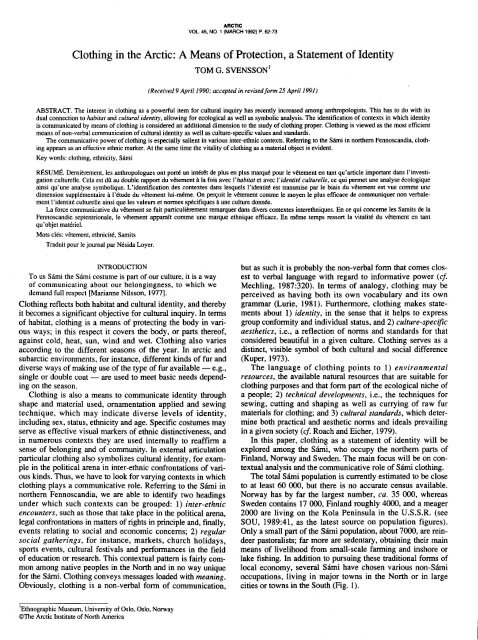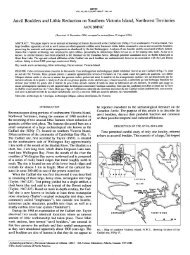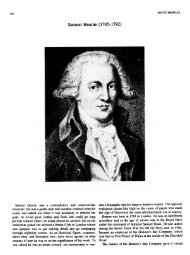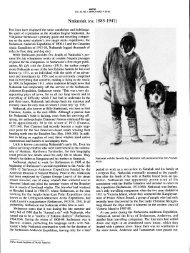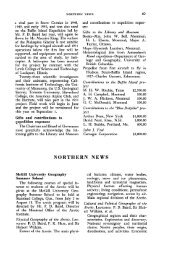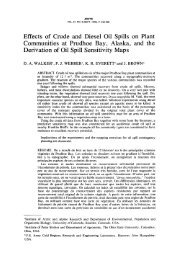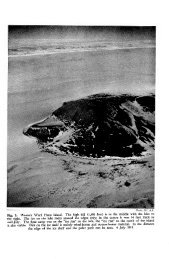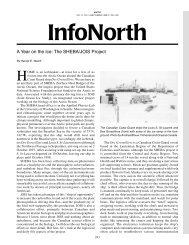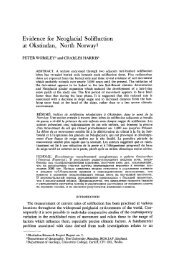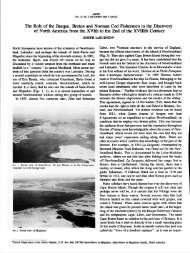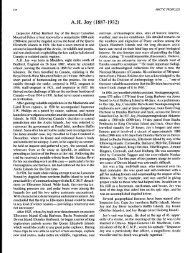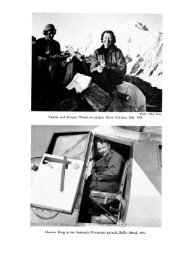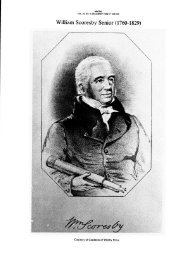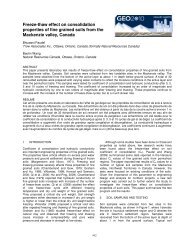Clothing in the Arctic - AINA Publications Server
Clothing in the Arctic - AINA Publications Server
Clothing in the Arctic - AINA Publications Server
You also want an ePaper? Increase the reach of your titles
YUMPU automatically turns print PDFs into web optimized ePapers that Google loves.
ARCTIC<br />
VOL, 45, NO. 1 (MARCH 1992) P. 62-73<br />
<strong>Cloth<strong>in</strong>g</strong> <strong>in</strong> <strong>the</strong> <strong>Arctic</strong>: A Means of Protection, a Statement of Identity<br />
TOM G. SVENSSON’<br />
(Received 9 April 1990; accepted <strong>in</strong> revised form 25 April 1991)<br />
ABSTRACT. The <strong>in</strong>terest <strong>in</strong> cloth<strong>in</strong>g as a powerful item for cultural <strong>in</strong>quiry has recently <strong>in</strong>creased among anthropologists. This has to do with its<br />
dual connection to habitat and cultural identify, allow<strong>in</strong>g for ecological as well as symbolic analysis. The identification of contexts <strong>in</strong> which identity<br />
is communicated by means of cloth<strong>in</strong>g is considered an additional dimension to <strong>the</strong> study of cloth<strong>in</strong>g proper. <strong>Cloth<strong>in</strong>g</strong> is viewed as <strong>the</strong> most efficient<br />
means of non-verbal communication of cultural identity as well as culture-specific values and standards.<br />
The communicative power of cloth<strong>in</strong>g is especially salient <strong>in</strong> various <strong>in</strong>ter-ethnic contexts. Referr<strong>in</strong>g to <strong>the</strong> Shi <strong>in</strong> nor<strong>the</strong>m Fennoscandia, cloth<strong>in</strong>g<br />
appears as an effective ethnic marker. At <strong>the</strong> same time <strong>the</strong> vitality of cloth<strong>in</strong>g as a material object is evident.<br />
Key words: cloth<strong>in</strong>g, ethnicity, Shi<br />
RÉSUMÉ. Demibrement, les anthropologues ont port6 un <strong>in</strong>t6rêt de plus en plus marqut pour le vêtement en tant qu’article important dans I’<strong>in</strong>vestigation<br />
culturelle. Cela est dû au double rapport du vêtement B la fois avec l’habitat et avec l’identité culturelle, ce qui permet une analyse kologique<br />
a<strong>in</strong>si qu’une analyse symbolique. L’identification des contextes dans lesquels I’identit6 est transmise par le biais du vêtement est vue comme une<br />
dimension supplémentaire B 1’6tude du vêtement lui-même. On perçoit le vêtement comme le moyen le plus efficace de communiquer non verbalement<br />
l’identité culturelle a<strong>in</strong>si que les valeurs et normes sp6cifiques B une culture donn6e.<br />
La force communicative du vêtement se fait particulibrement remarquer dans divers contextes <strong>in</strong>terethniques. En ce qui concerne les Samits de la<br />
Fennoscandie seDtentrionale, le vêtement apparaît _ _ comme une marque ethnique efficace. En même temps ressort la vitalit6 du vêtement en tant<br />
qu’objet matériel.<br />
Mots clés: vêtement, ethnicid, Samits<br />
Traduit pour le journal par N6sida Loyer.<br />
INTRODUCTION<br />
but as such it is probably <strong>the</strong> non-verbal form that comes clos-<br />
To us SBmi <strong>the</strong> Shi costume is part of our culture, it is a way<br />
of communicat<strong>in</strong>g about our belong<strong>in</strong>gness, to which we<br />
demand full respect [Marianne Nilsson, 19771.<br />
est to verbal language with regard to <strong>in</strong>formative power (cf.<br />
Mechl<strong>in</strong>g, 1987:320). In terms of analogy, cloth<strong>in</strong>g may be<br />
perceived as hav<strong>in</strong>g both its own vocabulary and its own<br />
<strong>Cloth<strong>in</strong>g</strong> reflects both habitat and cultural identity, and <strong>the</strong>reby grammar (Lurie, 1981). Fur<strong>the</strong>rmore, cloth<strong>in</strong>g makes stateit<br />
becomes a significant objective for cultural <strong>in</strong>quiry. In terms ments about 1) identity, <strong>in</strong> <strong>the</strong> sense that it helps to express<br />
of habitat, cloth<strong>in</strong>g is a means of protect<strong>in</strong>g <strong>the</strong> body <strong>in</strong> vari- group conformity and <strong>in</strong>dividual status, and 2) culture-specific<br />
ous ways; <strong>in</strong> this respect it covers <strong>the</strong> body, or parts <strong>the</strong>reof, aes<strong>the</strong>tics, i.e., a reflection of norms and standards for that<br />
aga<strong>in</strong>st cold, heat, sun, w<strong>in</strong>d and wet. <strong>Cloth<strong>in</strong>g</strong> also varies considered beautiful <strong>in</strong> a given culture. <strong>Cloth<strong>in</strong>g</strong> serves as a<br />
accord<strong>in</strong>g to <strong>the</strong> different seasons of <strong>the</strong> year. In arctic and dist<strong>in</strong>ct, visible symbol of both cultural and social difference<br />
subarctic environments, for <strong>in</strong>stance, different k<strong>in</strong>ds of fur and<br />
diverse ways of mak<strong>in</strong>g use of <strong>the</strong> type of fur available - e.g.,<br />
(Kuper, 1973).<br />
The language of cloth<strong>in</strong>g po<strong>in</strong>ts to 1) environmental<br />
s<strong>in</strong>gle or double coat - are used to meet basic needs depend- resources, <strong>the</strong> available natural resources that are suitable for<br />
<strong>in</strong>g on <strong>the</strong> season.<br />
cloth<strong>in</strong>g purposes and that form part of <strong>the</strong> ecological niche of<br />
<strong>Cloth<strong>in</strong>g</strong> is also a means to communicate identity through a people; 2) technical developments, i.e., <strong>the</strong> techniques for<br />
shape and material used, ornamentation applied and sew<strong>in</strong>g sew<strong>in</strong>g, cutt<strong>in</strong>g and shap<strong>in</strong>g as well as curry<strong>in</strong>g of raw fur<br />
technique, which may <strong>in</strong>dicate diverse levels of identity, materials for cloth<strong>in</strong>g; and 3) cultural standards, which deter<strong>in</strong>clud<strong>in</strong>g<br />
sex, status, ethnicity and age. Specific costumes may m<strong>in</strong>e both practical and aes<strong>the</strong>tic norms and ideals prevail<strong>in</strong>g<br />
serve as effective visual markers of ethnic dist<strong>in</strong>ctiveness, and <strong>in</strong> a given society (cf. Roach and Eicher, 1979).<br />
<strong>in</strong> numerous contexts <strong>the</strong>y are used <strong>in</strong>ternally to reaffirm a In this paper, cloth<strong>in</strong>g as a statement of identity will be<br />
sense of belong<strong>in</strong>g and of community. In external articulation explored among <strong>the</strong> Shi, who occupy <strong>the</strong> nor<strong>the</strong>rn parts of<br />
particular cloth<strong>in</strong>g also symbolizes cultural identity, for exam- F<strong>in</strong>land, Norway and Sweden. The ma<strong>in</strong> focus will be on conple<br />
<strong>in</strong> <strong>the</strong> political arena <strong>in</strong> <strong>in</strong>ter-ethnic confrontations of vari- textual analysis and <strong>the</strong> communicative role of Shi cloth<strong>in</strong>g.<br />
ous k<strong>in</strong>ds. Thus, we have to look for vary<strong>in</strong>g contexts <strong>in</strong> which The total Sbi population is currently estimated to be close<br />
cloth<strong>in</strong>g plays a communicative role. Referr<strong>in</strong>g to <strong>the</strong> Shi <strong>in</strong> to at least 60 000, but <strong>the</strong>re is no accurate census available.<br />
nor<strong>the</strong>rn Fennoscandia, we are able to identify two head<strong>in</strong>gs<br />
under which such contexts can be grouped: 1) <strong>in</strong>ter-ethnic<br />
Norway has by far <strong>the</strong> largest number, CU. 35 000, whereas<br />
Sweden conta<strong>in</strong>s 17 000, F<strong>in</strong>land roughly 4000, and a meager<br />
encounters, such as those that take place <strong>in</strong> <strong>the</strong> political arena, 2000 are liv<strong>in</strong>g on <strong>the</strong> Kola Pen<strong>in</strong>sula <strong>in</strong> <strong>the</strong> U.S.S.R. (see<br />
legal confrontations <strong>in</strong> matters of rights <strong>in</strong> pr<strong>in</strong>ciple and, f<strong>in</strong>ally,<br />
events relat<strong>in</strong>g to social and economic concerns; 2) regular<br />
SOU, 1989:41, as <strong>the</strong> latest source on population figures).<br />
Only a small part of <strong>the</strong> Shi population, about 7000, are re<strong>in</strong>social<br />
ga<strong>the</strong>r<strong>in</strong>gs, for <strong>in</strong>stance, markets, church holidays, deer pastoralists; far more are sedentary, obta<strong>in</strong><strong>in</strong>g <strong>the</strong>ir ma<strong>in</strong><br />
sports events, cultural festivals and performances <strong>in</strong> <strong>the</strong> field means of livelihood from small-scale farm<strong>in</strong>g and <strong>in</strong>shore or<br />
of education or research. This contextual pattern is fairly com- lake fish<strong>in</strong>g. In addition to pursu<strong>in</strong>g <strong>the</strong>se traditional forms of<br />
mon among native peoples <strong>in</strong> <strong>the</strong> North and <strong>in</strong> no way unique local economy, several SBmi have chosen various non-Shmi<br />
for <strong>the</strong> Shi. <strong>Cloth<strong>in</strong>g</strong> conveys messages loaded with mean<strong>in</strong>g. occupations, liv<strong>in</strong>g <strong>in</strong> major towns <strong>in</strong> <strong>the</strong> North or <strong>in</strong> large<br />
Obviously, cloth<strong>in</strong>g is a non-verbal form of communication, cities or towns <strong>in</strong> <strong>the</strong> South (Fig. 1).<br />
‘Ethnographic Museum, University of Oslo, Oslo, Norway<br />
@The <strong>Arctic</strong> Institute of North America
CLOTHING AMONG THE SAM1<br />
Varieties Based on Region and Material<br />
CLOTHING IN THE ARCTIC / 63<br />
Their way of life and climatic conditions have <strong>in</strong>fluenced<br />
<strong>the</strong> set of basic cloth<strong>in</strong>g developed among <strong>the</strong> SBmi. The<br />
cloth<strong>in</strong>g must be sufficiently warm, but at <strong>the</strong> same time it<br />
should meet <strong>the</strong> requirements of ease and comfort, enabl<strong>in</strong>g<br />
adequate freedom of motion. Simi traditions <strong>in</strong>dicate three<br />
different k<strong>in</strong>ds of coat, depend<strong>in</strong>g on material. Regardless of<br />
material used, however, <strong>the</strong> cut is quite similar, with <strong>the</strong> deviations<br />
be<strong>in</strong>g more regionally bound.<br />
In w<strong>in</strong>ter a double coat of re<strong>in</strong>deer sk<strong>in</strong>, muodda, was used<br />
all over <strong>the</strong> Shi land <strong>in</strong> a manner similar to that among many<br />
o<strong>the</strong>r arctic peoples. In summer a coat similarly shaped but<br />
made of cloth, homespun (gakti), or chamois (svaltja) was<br />
worn; <strong>the</strong> one of chamois is <strong>the</strong> oldest and by far <strong>the</strong> most last<strong>in</strong>g.<br />
The contrast is appreciable: one svultja is supposed to last<br />
as long as four gakti (Drake, 1918). In both w<strong>in</strong>ter and summer<br />
alternate coats were kept for everyday usage and for festive<br />
occasions, such as church holidays, markets, wedd<strong>in</strong>gs<br />
and funerals, to mention <strong>the</strong> most frequent events. Not idre-<br />
FIG. 2. Traditionally on diverse festivals and social events white was, and to<br />
some extent still is, a predom<strong>in</strong>ant colour among <strong>the</strong> Sdmi, both for fur coats<br />
and coats made of homespun, gakti. This picture from <strong>the</strong> early 1900s shows a<br />
quently <strong>the</strong> w<strong>in</strong>ter festival coat is made of white re<strong>in</strong>deer calfsk<strong>in</strong>,<br />
which is particularly soft and delicate and marks it off<br />
dist<strong>in</strong>ctively from regular coats. In o<strong>the</strong>r seasons <strong>the</strong> coat is<br />
group of Shi at <strong>the</strong> Tana market <strong>in</strong> F<strong>in</strong>nmark, nor<strong>the</strong>rn Norway. Photo:<br />
Ethnographic Museum, Oslo.<br />
made of white gakti (Fig. 2).<br />
beliefs suggest rigid cont<strong>in</strong>ence <strong>in</strong> all areas of embellishment.<br />
As a rule <strong>the</strong> woman’s gukti is longer, considerably wider One exception, however, is cloth<strong>in</strong>g, which appears far more<br />
and lacks a collar; <strong>in</strong> certa<strong>in</strong> areas its lower parts are also fur- ornamented and colourful than anyth<strong>in</strong>g else <strong>in</strong>volv<strong>in</strong>g home<br />
nished with plait<strong>in</strong>g. An apron, often with a conspicuously flo- and daily life. These aprons, with <strong>the</strong>ir conspicuous floral<br />
ral pattern, is commonly used as well, and s<strong>in</strong>ce <strong>the</strong> 1930s it ornamentation, were <strong>in</strong>tegrated as parts of Shi female coshas<br />
become a customary supplement to <strong>the</strong> woman’s dress. In tume and were apparently made acceptable to people who live<br />
recent years such aprons are worn mostly by older women, as under extremely Spartan and simple conditions and to whom<br />
<strong>in</strong> Gallivare, with its great number of laestadian devotees <strong>the</strong> po<strong>in</strong>t is to demonstrate that everyth<strong>in</strong>g aes<strong>the</strong>tic and use-<br />
(Fig. 3). This may seem to be a contradiction, as laestadian less is s<strong>in</strong>ful. This revivalist movement of laestadianism<br />
FIG. 1. Map of nor<strong>the</strong>rn Fennoscandia.<br />
derives its name from its founder Lars Levi Laestadius, a clergyman<br />
from Swedish Lapland of mixed SwedisNShi descent.<br />
The movement started <strong>in</strong> <strong>the</strong> 1830s <strong>in</strong> Karesuando, where<br />
Laestadius served as a priest. Soon afterwards it spread over a<br />
large part of Shi land, <strong>in</strong>corporat<strong>in</strong>g great numbers of Shi<br />
and F<strong>in</strong>ns among its believers. Ecstasy and exaggerative<br />
asceticism are characteristic features. (For fur<strong>the</strong>r <strong>in</strong>formation<br />
see Gjess<strong>in</strong>g, 1953, and Ruong, 198258.)<br />
Regionally <strong>the</strong> primary types of SBmi coats correspond<br />
closely to <strong>the</strong> difference between <strong>the</strong> ma<strong>in</strong> dialects of Shi:<br />
East Shi <strong>in</strong> nor<strong>the</strong>ast F<strong>in</strong>land and <strong>the</strong> Kola Pen<strong>in</strong>sula <strong>in</strong> <strong>the</strong><br />
U.S.S.R.; North Shi <strong>in</strong> northwest F<strong>in</strong>land and <strong>the</strong> nor<strong>the</strong>rnmost<br />
regions of Norway and Sweden; Central Shi, ma<strong>in</strong>ly <strong>in</strong><br />
Swedish Lapland but also among correspond<strong>in</strong>g Shi groups<br />
on <strong>the</strong> Norwegian side of <strong>the</strong> border; and f<strong>in</strong>ally South Shi <strong>in</strong><br />
both Sweden and Norway.<br />
Except for <strong>the</strong> w<strong>in</strong>ter fur coat, few dist<strong>in</strong>ctive marks rema<strong>in</strong><br />
among <strong>the</strong> East Sfimi, for Westem-style cloth<strong>in</strong>g has long<br />
been used dur<strong>in</strong>g <strong>the</strong> entire temperate season. Po<strong>in</strong>ted lea<strong>the</strong>r<br />
moccas<strong>in</strong>s toge<strong>the</strong>r with special shoe ribbons and women’s<br />
caps (samsud) are <strong>the</strong> only items surviv<strong>in</strong>g that reflect cultural<br />
identity (Figs. 4,5).<br />
The coat made of cloth (gakti) displays <strong>the</strong> greatest regional<br />
divergence, with variations seen <strong>in</strong> colour, shape and embellishment.<br />
The basic colour of <strong>the</strong> cloth is blue <strong>in</strong> various shades,<br />
but black and white occur, as well as green <strong>in</strong> rare <strong>in</strong>stances. A<br />
few narrow ships <strong>in</strong> red, yellow, green and blue, colours characteristic<br />
for all SBmi ornamentation, are attached <strong>in</strong> such a<br />
way as to beautify <strong>the</strong> costume and make it regionally dist<strong>in</strong>ctive.<br />
These also have a practical purpose as <strong>the</strong>y cover some of
64 I T.G. SVENSSON<br />
<strong>the</strong> crucial seams, streng<strong>the</strong>n<strong>in</strong>g <strong>the</strong>se parts of <strong>the</strong> coat<br />
(Porsbo, 1988:37). Obviously <strong>the</strong> use of blue or green ribbons<br />
is dependent on <strong>the</strong> choice of basic colour for <strong>the</strong> coat. The<br />
shape may vary with regard to <strong>the</strong> k<strong>in</strong>d of collar, whe<strong>the</strong>r <strong>the</strong><br />
coat has a small or large chest open<strong>in</strong>g and how wide it is.<br />
Moreover, <strong>the</strong> degree and sort of embellishment gives a clear<br />
<strong>in</strong>dication of regional peculiarity. In certa<strong>in</strong> areas we f<strong>in</strong>d<br />
coats with very conspicuous ornamentation, <strong>the</strong> coat almost<br />
totally covered by broad ribbons <strong>in</strong> vary<strong>in</strong>g embroidery pat-<br />
terns and colours; <strong>in</strong> o<strong>the</strong>r regions more sober adornments are<br />
salient (Figs. 6,7).<br />
The <strong>in</strong>troduction of <strong>the</strong> sew<strong>in</strong>g mach<strong>in</strong>e <strong>in</strong> <strong>the</strong> 1920s<br />
brought forth a change <strong>in</strong> <strong>the</strong> choice of textile material. Home-<br />
spun was completely abandoned and <strong>the</strong> Simi seamstresses<br />
turned to th<strong>in</strong>ner, manufactured fabrics; at <strong>the</strong> same time <strong>the</strong>y<br />
could elaborate more lavishly on ornamentation (cf. Porsbo,<br />
1988:24). At times such excessive embellishments were seri-<br />
ously opposed <strong>in</strong> areas where <strong>the</strong> laestadian faith predom<strong>in</strong>ated.<br />
The western Laestadians, liv<strong>in</strong>g <strong>in</strong> <strong>the</strong> Jukkasjarvi-<br />
Gallivare region on both sides of <strong>the</strong> Swedish-Norwegian bor-<br />
der, were <strong>the</strong> most severe advocates of cont<strong>in</strong>ence, whereas<br />
<strong>the</strong> eastern Laestadians, liv<strong>in</strong>g far<strong>the</strong>r to <strong>the</strong> north, were more<br />
liberal. The difference of views here is reflected <strong>in</strong> traditional<br />
cloth<strong>in</strong>g patterns.<br />
The coats <strong>in</strong> F<strong>in</strong>nmark and Karesuando are designated by<br />
an extra high collar with a small chest open<strong>in</strong>g. They are very<br />
FIG. 3. Asa Kitok, from Gallivare, Swedish Lapland, dressed <strong>in</strong> traditional<br />
woman’s headdress, marjuk, and with apron with a floral pattern. Photo:<br />
T. Svensson, 1975.<br />
wide, almost baggy, and this effect is emphasized as <strong>the</strong>y are<br />
girded by a broad lea<strong>the</strong>r belt. With few exceptions <strong>the</strong> embel-<br />
lishment is also highly elaborated. A transitional type of coat<br />
is found <strong>in</strong> JukkasjWi and Gallivare (Figs. 3, €9, somewhat<br />
more restra<strong>in</strong>ed <strong>in</strong> both shape and adornments. The <strong>in</strong>termedi-<br />
ate style proper between <strong>the</strong> two extremes found <strong>in</strong> north and<br />
south is <strong>the</strong> one <strong>in</strong> Jokkmokk and Arjeplog and adjo<strong>in</strong><strong>in</strong>g<br />
areas <strong>in</strong> Norway, i.e., <strong>in</strong> <strong>the</strong> core area of Central Simi habita-<br />
tion. This coat is recognized by its narrower width and sparse<br />
ornamentation. A larger open<strong>in</strong>g <strong>in</strong> <strong>the</strong> chest to which a beauti-<br />
fully decorated chest piece is attached appears as its most pro-<br />
nounced section (Fig. 7).<br />
F<strong>in</strong>ally, <strong>in</strong> <strong>the</strong> South S hi area on both sides of <strong>the</strong> national<br />
border, <strong>in</strong>clud<strong>in</strong>g <strong>the</strong> Forest S hi <strong>in</strong> Swedish Lapland, people<br />
wear a half-length, gently cl<strong>in</strong>g<strong>in</strong>g coat with a large chest<br />
open<strong>in</strong>g with a chest piece, mostly decorated with t<strong>in</strong>-thread<br />
embroidery <strong>in</strong> strict but very complex patterns. This coat is<br />
furnished with a markedly low collar, and <strong>in</strong> modem times it<br />
is usually dark blue or black, sewn ei<strong>the</strong>r <strong>in</strong> common wool or<br />
cheviot, and it is worn with match<strong>in</strong>g long trousers. The belt,<br />
embroidered with t<strong>in</strong> thread, is comparatively very narrow and<br />
has a negligible effect on <strong>the</strong> hang of <strong>the</strong> coat. Apart from <strong>the</strong><br />
cap, <strong>the</strong> chest piece is probably <strong>the</strong> part of <strong>the</strong> costume that<br />
varies <strong>the</strong> most between different localities with<strong>in</strong> <strong>the</strong> South<br />
Shi region (Fig. 9).<br />
Regardless of vary<strong>in</strong>g shapes, <strong>the</strong> S hi coat appears fairly<br />
large and puffed up. It is important that it is not tight <strong>in</strong> order<br />
to facilitate movement and also for putt<strong>in</strong>g on “<strong>in</strong> one fast<br />
throw,” as <strong>the</strong>y say (Porsbo, 1988:36). The belt around <strong>the</strong> waist<br />
of this puffy coat offers sufficient space for keep<strong>in</strong>g valuables,<br />
such as purse, tobacco and pipe, which is essential as <strong>the</strong>re are<br />
no pockets attached to <strong>the</strong> coat. In order to give fur<strong>the</strong>r<br />
FIG.<br />
4. Fetsi Sverdloff, from Suenjel, nor<strong>the</strong>ast F<strong>in</strong>land, wear<strong>in</strong>g typical East<br />
Shi headdress for married women, shamshik. Photo: Karl Nickul, 1932.
CLOTHING IN THE ARCTIC / 65<br />
FIG. 5. East Shi youth from Natjavre play<strong>in</strong>g. As we can see, footwear and caps are <strong>the</strong> only dist<strong>in</strong>ctive cloth<strong>in</strong>g features among both boys and girls. Photo: Ellisef<br />
Wessel, Ethnographic Museum, Oslo, c. 1900.<br />
protection under extreme wea<strong>the</strong>r conditions, <strong>in</strong> particular<br />
aga<strong>in</strong>st wet and severe w<strong>in</strong>d, <strong>the</strong> Shi have developed a special<br />
cover<strong>in</strong>g of homespun or cloth (luhkka) cut as a short poncho<br />
with hood, but large enough to cover <strong>the</strong> <strong>in</strong>dispensable<br />
rucksack, <strong>in</strong> addition to head, neck and shoulders.<br />
The decisive change <strong>in</strong> w<strong>in</strong>ter cloth<strong>in</strong>g from fur to textile<br />
occurred <strong>in</strong> <strong>the</strong> 1920s (cf. Porsbo, 1988:49). After <strong>the</strong> <strong>in</strong>troduction<br />
of <strong>the</strong> snowmobile, however, <strong>the</strong> use of both coats and<br />
trousers of fur has come back and seems to be steadily <strong>in</strong>creas<strong>in</strong>g.<br />
Shoes and mittens of fur are reta<strong>in</strong>ed, even if some special<br />
skidoo boots are tried out as well. In <strong>the</strong> op<strong>in</strong>ion of many Shi re<strong>in</strong>deer pastoralists, fur cloth<strong>in</strong>g appears superior to any manufactured<br />
clo<strong>the</strong>s, because you sit ra<strong>the</strong>r still on <strong>the</strong> skidoo for<br />
many hours each day dur<strong>in</strong>g herd<strong>in</strong>g activities and are thus<br />
exposed to much more strong w<strong>in</strong>d and cold than when you<br />
move slowly and tenaciously on skis. The use of <strong>the</strong> luhkka<br />
has been revived for <strong>the</strong> same reasons (Porsbo, 1988:67).<br />
To express high status silver was used <strong>in</strong> <strong>the</strong> cloth<strong>in</strong>g;<br />
under more festive circumstances both men and women wore<br />
a special belt adorned with silver applications that <strong>in</strong>dicated<br />
fortune <strong>in</strong> re<strong>in</strong>deer herds. The women also employed a silver<br />
collar (silbahalsie) to beautify <strong>the</strong> costume for special occasions,<br />
such as wedd<strong>in</strong>gs, church holidays and important market<br />
days, and to express wealth. This silver collar was attached<br />
to <strong>the</strong> woman’s coat <strong>in</strong> <strong>the</strong> front as an enlarged chest piece<br />
exuberantly decorated with numerous hang<strong>in</strong>g buttons, loops<br />
and clasps made of silver (Fjellstrom, 1962). With few exceptions,<br />
this k<strong>in</strong>d of adornment show<strong>in</strong>g high status was most<br />
commonly used <strong>in</strong> sou<strong>the</strong>rn and central Shi land.<br />
The type of cloth<strong>in</strong>g hav<strong>in</strong>g <strong>the</strong> greatest impact <strong>in</strong> manifestations<br />
of identity is undoubtedly <strong>the</strong> headdress. Women, <strong>in</strong><br />
particular, ma<strong>in</strong>ta<strong>in</strong> <strong>the</strong> significance of <strong>the</strong> cap, and <strong>in</strong> many<br />
areas it is <strong>the</strong> last cloth<strong>in</strong>g item to be rel<strong>in</strong>quished (Agren,<br />
1977). The cap represents <strong>the</strong> most evident mark<strong>in</strong>g of identity<br />
<strong>in</strong> terms of locality, gender and marital status.<br />
With<strong>in</strong> <strong>the</strong> same region men’s and women’s caps are, as a<br />
rule, pronouncedly different. Men’s caps are <strong>the</strong> only ones<br />
provided with a peak, usually of lea<strong>the</strong>r, <strong>the</strong> practical use of<br />
which is to protect <strong>the</strong> eyes aga<strong>in</strong>st w<strong>in</strong>d and sun exposure.<br />
The red tassel of woolen yam, <strong>in</strong> variable sizes and attached<br />
on top of <strong>the</strong> cap, is ano<strong>the</strong>r visual sign of male identity. The<br />
cap with such a tassel is a very colourful item and is peculiar<br />
for <strong>the</strong> region <strong>in</strong>clud<strong>in</strong>g <strong>the</strong> parishes of Karesuando, Jukkasjhi<br />
and Giillivare; Karesuando has <strong>the</strong> largest tassel as one of<br />
its dist<strong>in</strong>ctive marks, whereas far<strong>the</strong>r to <strong>the</strong> south a variation<br />
consist<strong>in</strong>g of a fairly high wedge-shaped cap (tjupp) for both<br />
men and women is prevalent (Figs. 10, 11).<br />
In contrast to <strong>the</strong> m<strong>in</strong>or variations <strong>in</strong> men’s caps <strong>in</strong> <strong>the</strong><br />
nor<strong>the</strong>rnmost region of Swedish Lapland, women’s caps are<br />
highly dist<strong>in</strong>ctive. The Karesuando cap (iorbor) is ra<strong>the</strong>r flat<br />
and rounded, with a large white lace border attached around<br />
<strong>the</strong> lower edge (Fig. 12). The dourran is a traditional cap used<br />
<strong>in</strong> Jukkasjhi and adjacent parts of Norway. For many years<br />
its use decreased, but it has recently been revived by some<br />
young women <strong>in</strong> <strong>the</strong> area. Its front section is dist<strong>in</strong>guished by<br />
elaborately ornamented woven borders and <strong>the</strong> part of <strong>the</strong><br />
crown is low and tightly wr<strong>in</strong>kled (Fig. 13). F<strong>in</strong>ally, <strong>in</strong> Gallivare<br />
women wore a narrow, high cap (matjuk) sparsely ornamented<br />
and with folded top (Fig. 14). Even this cap has come<br />
back to some extent, after many years of decreas<strong>in</strong>g use. Of<br />
<strong>the</strong>se three women’s caps, jorbor is by far <strong>the</strong> one used most.<br />
None of <strong>the</strong>se caps was particularly good at protect<strong>in</strong>g<br />
aga<strong>in</strong>st severe cold. For this reason women wore a specially<br />
designed outer cap <strong>in</strong> w<strong>in</strong>ter <strong>in</strong> both Karesuando and Jukkasjarvi,<br />
whereas <strong>in</strong> Gallivare a shawl tied around <strong>the</strong> matjuk<br />
served <strong>the</strong> same purpose (Porsbo, 1988:63).<br />
In F<strong>in</strong>nmark and northwest F<strong>in</strong>nish Lapland we f<strong>in</strong>d a fourpo<strong>in</strong>ted<br />
cap (savka), poetically called “<strong>the</strong> cap of <strong>the</strong> four<br />
w<strong>in</strong>ds,” or ra<strong>the</strong>r card<strong>in</strong>al po<strong>in</strong>ts, worn <strong>in</strong> several varieties by<br />
<strong>the</strong> men. The most observable difference is that between <strong>the</strong><br />
caps of Karasjok and Kautoke<strong>in</strong>o (Figs. 6, 15). In this region<br />
<strong>the</strong>se men’s caps are contrasted with very dist<strong>in</strong>ctive women’s<br />
caps, <strong>the</strong> most conspicuous of which is <strong>the</strong> homed cap (ladjo)<br />
(Figs. 16, 17). For practical reasons <strong>the</strong> characteristic homed<br />
cap disappeared long ago and by <strong>the</strong> turn of <strong>the</strong> last century<br />
very few women still wore it (Gjess<strong>in</strong>g, 1940). Instead, women
66 1 T.G. SVENSSON<br />
eventually turned to a soft but fairly large cap with elaborate<br />
embellishment (Fig. 18). Recently this homed cap has been<br />
revived and its dist<strong>in</strong>ctive shape and ancient usage among<br />
most of <strong>the</strong> nor<strong>the</strong>rn Shi gives it special symbolic power.<br />
By means of different shapes of <strong>the</strong> cap women may also<br />
dist<strong>in</strong>guish marital status, as, for example, among <strong>the</strong> Skolt<br />
Shi <strong>in</strong> nor<strong>the</strong>ast F<strong>in</strong>land, who traditionally used three dissimilar<br />
caps. For unmarried girls a low head cover<strong>in</strong>g (pervesk)<br />
(Fig. 19), expos<strong>in</strong>g <strong>the</strong> entire crown, was used. Married women,<br />
on <strong>the</strong> o<strong>the</strong>r hand, wore a cap (shamshik or samsad) that was<br />
much higher <strong>in</strong> <strong>the</strong> front and also decorated <strong>in</strong> a more elaborate<br />
fashion. Widows, f<strong>in</strong>ally, had a special cap too (povednik),<br />
which was comparatively flat at <strong>the</strong> front and less<br />
lavishly ornamented (Nickul, 1948; Figs. 4, 20).<br />
Contextual Analysis<br />
In order to understand <strong>the</strong> communicative power of cloth<strong>in</strong>g,<br />
one must discover <strong>in</strong> which situations culture-specific<br />
cloth<strong>in</strong>g is used as a means to communicate identity and to<br />
confirm belong<strong>in</strong>g. Four primary types of contexts where dist<strong>in</strong>ct<br />
dresses are used can be identified. First <strong>the</strong>re is <strong>the</strong> everyday<br />
life situation related to re<strong>in</strong>deer herd<strong>in</strong>g or o<strong>the</strong>r<br />
traditional activities. In such situations dist<strong>in</strong>ctive Shi cloth<strong>in</strong>g,<br />
fairly worn out, is still <strong>in</strong> use by quite a few people as a<br />
FIG. 6. Man’s coat and cap from Kautoke<strong>in</strong>o with elaborate ornamentation.<br />
Photo: Ann Christ<strong>in</strong>e Ekk, Ethnographic Museum, Oslo.<br />
natural way to manifest attachment to a particular culture. The<br />
number reta<strong>in</strong><strong>in</strong>g SBmi cloth<strong>in</strong>g <strong>in</strong> this connection is constantly<br />
decreas<strong>in</strong>g to <strong>the</strong> advantage of more Westem-<strong>in</strong>spired<br />
cloth<strong>in</strong>g.<br />
Far more significant are contexts related to political life and<br />
cultural events. Cultural events such as wedd<strong>in</strong>gs, funerals,<br />
confirmations and special annual church holidays have had a<br />
special mean<strong>in</strong>g to <strong>the</strong> Shi ever s<strong>in</strong>ce <strong>the</strong>y were Christianized<br />
and are occasions when <strong>the</strong> f<strong>in</strong>est set of SBmi costumes,<br />
toge<strong>the</strong>r with <strong>the</strong> most precious adornments, are commonly<br />
used. Traditional market days, such as those held <strong>in</strong> Jokkmokk,<br />
Gtillivare and o<strong>the</strong>r centres of SBmi habitation, and <strong>the</strong><br />
Easter holiday celebration <strong>in</strong> Kautoke<strong>in</strong>o are o<strong>the</strong>r regular<br />
ga<strong>the</strong>r<strong>in</strong>gs where <strong>the</strong> Shi costume is frequently used.<br />
Art or handicraft exhibitions where SBmi are actively or<br />
passively present are o<strong>the</strong>r reappear<strong>in</strong>g events <strong>in</strong> which <strong>the</strong><br />
SBmi costume is highly relevant; <strong>the</strong> same is true for SBmi<br />
sports championships and diverse staged performances <strong>in</strong> <strong>the</strong><br />
fields of film, <strong>the</strong>atre and concert, as well as general cultural<br />
festivals. Those who perform, as well as <strong>the</strong> great majority of<br />
<strong>the</strong> audience, wear Simi cloth<strong>in</strong>g on <strong>the</strong>se occasions. O<strong>the</strong>r<br />
situations of a cultural nature <strong>in</strong>volve participation <strong>in</strong> <strong>the</strong> Shi school system, ei<strong>the</strong>r as a student or as a member of <strong>the</strong> school<br />
board, or <strong>in</strong> academic performances, such as public doctoral<br />
defences and scholarly conferences. In <strong>the</strong>se latter situations<br />
both <strong>the</strong> primary performer and members of <strong>the</strong> audience<br />
make a po<strong>in</strong>t of wear<strong>in</strong>g SBmi costume. To wear unmistakably<br />
Shi dress on such ceremonious occasions, with <strong>the</strong>ir special<br />
rules of etiquette and conduct def<strong>in</strong>ed exclusively by <strong>the</strong><br />
majority, conveys a message loaded with mean<strong>in</strong>g to <strong>the</strong> outside<br />
world. Here cultural pride is united with <strong>the</strong> satisfaction<br />
of academic achievements, and <strong>the</strong> most efficient visual means<br />
to present this message is by means <strong>the</strong> of Shi costume.<br />
FIG. 7. Man’s coat from Tysfjord, Central Shi type, show<strong>in</strong>g restra<strong>in</strong>ed adomments.<br />
Draw<strong>in</strong>g: Viktor Eliassen, Ethnographic Museum, Oslo.
68 1 T.G. SVENSSON<br />
Practically all of <strong>the</strong> cultural events mentioned here are<br />
generated by culture contact; <strong>the</strong>y are situations def<strong>in</strong>ed as<br />
unequivocally S hi but where Shi and non-Shi meet with<br />
a similar purpose <strong>in</strong> m<strong>in</strong>d, Le., to enjoy someth<strong>in</strong>g specifically<br />
SBmi. Consequently, even apart from politics and <strong>in</strong>ter-ethnic<br />
controversies, <strong>the</strong> S hi are given ample opportunities to make<br />
<strong>the</strong>mselves noticed <strong>in</strong> society, us<strong>in</strong>g S hi cloth<strong>in</strong>g as one of<br />
<strong>the</strong>ir most prom<strong>in</strong>ent non-verbal messages about identity.<br />
For <strong>the</strong> sake of simplicity, contexts related to political life<br />
can be divided <strong>in</strong>to two types: 1) those deal<strong>in</strong>g with <strong>in</strong>ternal<br />
political ga<strong>the</strong>r<strong>in</strong>gs or meet<strong>in</strong>gs, and 2) <strong>the</strong> ones hav<strong>in</strong>g to do<br />
FIG 13. Woman’s cap, duorran, from Jukkasjarvi, Norsk Folkemuseum, Oslo,<br />
nr Sa 1670, collected <strong>in</strong> 1926.<br />
with various <strong>in</strong>ter-ethnic political encounters. The first variant<br />
reflects diverse forms of more or less formal assemblies held<br />
by SBmi national and <strong>in</strong>ter-Nordic organizations or by local<br />
associations, which non-Shi may attend as auditors <strong>in</strong> many<br />
<strong>in</strong>stances. Examples of such recurr<strong>in</strong>g meet<strong>in</strong>gs are national<br />
assemblies held once a year by Swedish, Norwegian and<br />
F<strong>in</strong>nish SBmi, national meet<strong>in</strong>gs of Shi Nuora (SBmi Youth<br />
Association), SameAtnam (SBmi National Association Con-<br />
cern<strong>in</strong>g Cultural Matters), Nordic S hi conferences held every<br />
three years, and <strong>the</strong> organizational work and specific activities<br />
of S hi Institutta (Nordic S hi Institute) <strong>in</strong> Kautoke<strong>in</strong>o. More<br />
HG. 14. Woman’s cap. matjuk, from Glllivare. Photo: T. Svensson, 1975.<br />
FIG. 15 Man’s cap, Karasjok-style. Photo: Ethnographic Museum, Oslo, 1918.
70 I T.G. SVENSSON<br />
costume may not be used by all delegates throughout <strong>the</strong><br />
entire assembly, last<strong>in</strong>g for several days; for <strong>the</strong> sake of convenience<br />
it may be replaced now and <strong>the</strong>n by common cloth<strong>in</strong>g.<br />
However, on <strong>the</strong> open<strong>in</strong>g and clos<strong>in</strong>g days, which are <strong>the</strong><br />
most significant s<strong>in</strong>ce <strong>the</strong> greatest number of authorities and<br />
representatives of <strong>the</strong> mass media are among <strong>the</strong> audience, <strong>the</strong><br />
SBmi costume is a predom<strong>in</strong>ant and very colourful feature,<br />
both among <strong>the</strong> political elite and among all grass-root SBmi<br />
present.<br />
As far as external political encounters are concerned, vary<strong>in</strong>g<br />
formal fora for political activities dom<strong>in</strong>ate. Shi cloth<strong>in</strong>g<br />
is an attribute frequently made use of <strong>in</strong> such different situations<br />
as court trials, <strong>in</strong> particular <strong>the</strong> ones refemng to <strong>the</strong> aborig<strong>in</strong>al<br />
rights issue, or <strong>in</strong> meet<strong>in</strong>g as delegates with political<br />
authorities or officials <strong>in</strong> order to negotiate or exchange <strong>in</strong>formation<br />
concern<strong>in</strong>g Shi affairs. These fora represent vital ethnopolitical<br />
arenas through which Shi politics are channeled.<br />
O<strong>the</strong>r ethnopolitical encounters for which <strong>the</strong> wear<strong>in</strong>g of Shi cloth<strong>in</strong>g makes sense are when serv<strong>in</strong>g as delegates <strong>in</strong> governmental<br />
<strong>in</strong>quiries, <strong>the</strong> latest of which are <strong>the</strong> well-known Shi Rights Committees, presently at work <strong>in</strong> all <strong>the</strong> Nordic countries<br />
with Shi populations, and participation <strong>in</strong> public debates<br />
about general SBmi claims. F<strong>in</strong>ally, SBmi costume is used<br />
effectively dur<strong>in</strong>g confrontations regard<strong>in</strong>g more specific<br />
cases of exploitation; <strong>the</strong>se mostly end up as negotiations<br />
about recompensation to <strong>the</strong> Shi for suffered losses, because<br />
so far <strong>the</strong> Shi lack effective means of veto<strong>in</strong>g proposed cases<br />
of <strong>in</strong>dustrial or tourist development. The choice of wear<strong>in</strong>g <strong>the</strong><br />
Shi dress re<strong>in</strong>forces a Shi def<strong>in</strong>ition of <strong>the</strong> situation, with<br />
its visual mark <strong>in</strong>dicat<strong>in</strong>g cultural difference. Thereby <strong>the</strong> non-<br />
SBmi party will be fully aware of <strong>the</strong> fact that a current confrontation<br />
is not merely a common controversy of diverg<strong>in</strong>g<br />
<strong>in</strong>terests, but a conflict to be resolved between actors represent<strong>in</strong>g<br />
two different cultures. It is probably no overstatement<br />
to ma<strong>in</strong>ta<strong>in</strong> that <strong>the</strong> Shi costume, with its non-verbal articulative<br />
strength, plays a role <strong>in</strong> all <strong>the</strong>se formal and semi-formal<br />
ethno-political fora.<br />
Spontaneous protest actions <strong>in</strong> <strong>the</strong> form of large demonstrations,<br />
with explicit statements presented on banners, such as<br />
“We were here first, we will not leave” or “SBmi power <strong>in</strong><br />
SBmi land” are <strong>in</strong>formal encounters express<strong>in</strong>g clear political<br />
messages. These demonstrations take place ei<strong>the</strong>r close to <strong>the</strong><br />
actual place for a proposed development or outside <strong>the</strong><br />
Supreme Court build<strong>in</strong>g <strong>in</strong> Stockholm, such as <strong>the</strong> one dur<strong>in</strong>g<br />
<strong>the</strong> largest court case ever to be tried on rights <strong>in</strong> pr<strong>in</strong>ciple, <strong>the</strong><br />
land rights claims of <strong>the</strong> Taxed Mounta<strong>in</strong>s Case. Ano<strong>the</strong>r<br />
example was <strong>the</strong> spectacular hunger strike <strong>in</strong> Oslo <strong>in</strong> front of<br />
<strong>the</strong> Norwegian Parliament dur<strong>in</strong>g <strong>the</strong> Alta Case, with its unexpected<br />
and ra<strong>the</strong>r far-reach<strong>in</strong>g implications (Fig. 21). The Alta<br />
Case represents a protest movement <strong>in</strong> which <strong>the</strong> Shi tried to<br />
prevent a hydro-power development <strong>in</strong> F<strong>in</strong>nmark <strong>in</strong> 1979-80.<br />
This was <strong>the</strong> first large-scale mobilization of SBmi based on<br />
ethnicity. Needless to say, Shi cloth<strong>in</strong>g has a def<strong>in</strong>ite place<br />
<strong>in</strong> such ethno-political manifestations. The visual nearness and<br />
rem<strong>in</strong>der of an ethnically dist<strong>in</strong>ct m<strong>in</strong>ority group helps to create<br />
sympathy and public op<strong>in</strong>ion favourable to <strong>the</strong> Shi cause.<br />
To achieve such ends Shi cloth<strong>in</strong>g is one <strong>in</strong> a set of <strong>in</strong>dispensable<br />
traits to be emphasized <strong>in</strong> such situations of direct<br />
cultural contact.<br />
The discussion of relevant contexts would be <strong>in</strong>complete<br />
without attention to <strong>the</strong> use of native cloth<strong>in</strong>g <strong>in</strong> urban sett<strong>in</strong>gs.<br />
For Shi liv<strong>in</strong>g <strong>in</strong> a capital, such as Oslo, far away from<br />
common SBmi habitations, <strong>the</strong> question rema<strong>in</strong>s, to what<br />
extent is SBmi cloth<strong>in</strong>g a useful cultural elemenl :? Althc ough<br />
<strong>the</strong>re are about 5000 Shi <strong>in</strong> Oslo, about 1% of <strong>the</strong> total popu-<br />
lation, <strong>the</strong>y rema<strong>in</strong> extremely marg<strong>in</strong>al and mostly non-visible<br />
as a group <strong>in</strong> such an urban sett<strong>in</strong>g. The contexts considered<br />
appropriate, <strong>the</strong>refore, are chosen with great care. They are<br />
ei<strong>the</strong>r safe S hi situations, such as more or less closed festival<br />
occasions, <strong>the</strong> admittance to which <strong>the</strong> Shi fully control, or<br />
important political and cultural manifestations. Among politi-<br />
cal events <strong>the</strong> Alta protest, last<strong>in</strong>g for several months, now<br />
stands as <strong>the</strong> most conspicuous occurrence, hav<strong>in</strong>g great<br />
impact on <strong>the</strong> <strong>in</strong>habitants of Oslo. In those days <strong>the</strong> SBmi cos-<br />
tume was a very common feature on <strong>the</strong> streets of central<br />
Oslo. Some Shi, who had been liv<strong>in</strong>g <strong>in</strong> Oslo for years, <strong>the</strong>n<br />
started to wear S hi cloth<strong>in</strong>g more openly, <strong>the</strong>reby express<strong>in</strong>g<br />
<strong>the</strong>ir solidarity with <strong>the</strong> S hi political cause (Ulfrstad, 1989).<br />
O<strong>the</strong>r political occasions are <strong>the</strong> National Meet<strong>in</strong>g of NSR<br />
(<strong>the</strong> National Union of Norwegian Shi) <strong>in</strong> 1985 and count-<br />
less meet<strong>in</strong>gs with national or communal authorities. Concerts<br />
<strong>in</strong> one of <strong>the</strong> exist<strong>in</strong>g large auditoriums present<strong>in</strong>g genu<strong>in</strong>e<br />
SBmi music, yoik - both traditional vocalizations and more<br />
modem forms mak<strong>in</strong>g use of jazz- or rock-<strong>in</strong>spired accompa-<br />
niment - are popular events where <strong>the</strong> use of SBmi costume<br />
is considered appropriate. So are SBmi crafts exhibitions and<br />
such unique opportunities as <strong>the</strong> world premiere of <strong>the</strong> first<br />
I FIG. 20 The East Sami subsisted on freshwater fish<strong>in</strong>g toge<strong>the</strong>r with small,<br />
1 semi-domesticated herds of re<strong>in</strong>deer. This picture shows a group of Skolt<br />
I Sami <strong>in</strong> typical surround<strong>in</strong>gs. The two women to <strong>the</strong> left <strong>in</strong> <strong>the</strong> boat wear<br />
1 wives’ caps, whereas two o<strong>the</strong>r women far<strong>the</strong>r to <strong>the</strong> right wear widows’ caps.<br />
1 Photo: probably c. 1900, Ethnographic Museum, Oslo.<br />
FIG. 21. In autumn 1979 <strong>the</strong> Shi chose a new strategy <strong>in</strong> protest<strong>in</strong>g aga<strong>in</strong>st a<br />
hydro-power development <strong>in</strong> <strong>the</strong> Alta River <strong>in</strong> West F<strong>in</strong>nmark. The Shi put<br />
up a typical Simi tent, lbvvo, <strong>in</strong> downtown Oslo close to <strong>the</strong> Norwegian<br />
Parliament and seven young Shi went on a hunger strike for several weeks.<br />
The banner reads: “No to governmental and parliamentary decisions above<br />
our heads!” Photo: Elisabeth Sletten, Ethnographic Museum, Oslo.
CLOTHING IN THE ARCTIC / 71<br />
Shi action movie, Veiviseren (Path-f<strong>in</strong>der), with its dramatic In order to legitimize aborig<strong>in</strong>al claims such diversification is<br />
legendary motif, a film nom<strong>in</strong>ated for an Academy Award <strong>in</strong> necessary. How much of a cloth<strong>in</strong>g style needs to be Shi <strong>in</strong><br />
1988. Many Shi attended this premiere show, most dressed order to convey this particular mean<strong>in</strong>g? In some cases <strong>the</strong><br />
<strong>in</strong> <strong>the</strong>ir f<strong>in</strong>est costume and adornments, for this was an excep- highly dist<strong>in</strong>guished cap alone will suffice, as among many<br />
tional festive occasion <strong>in</strong> which <strong>the</strong> Shi played <strong>the</strong> ma<strong>in</strong> part women; <strong>in</strong> o<strong>the</strong>r <strong>in</strong>stances <strong>the</strong> characteristically po<strong>in</strong>ted shoes<br />
throughout. This was a situation that no doubt re<strong>in</strong>forced both toge<strong>the</strong>r with woven shoe ribbons are satisfactory to <strong>in</strong>dicate<br />
pride and self-respect among <strong>the</strong> SBmi. Consequently, even <strong>in</strong> unequivocal cultural identity to outsiders. If a Shi man is<br />
urban sett<strong>in</strong>gs far from core areas of SBmi habitation, it is by nicely dressed up <strong>in</strong> a suit for a formal event or is appear<strong>in</strong>g <strong>in</strong><br />
no means <strong>in</strong>appropriate to wear Shi cloth<strong>in</strong>g; as predicted, court, where one has to wear a lawyer’s black gown, simply a<br />
however, its use <strong>the</strong>re is far less frequent.<br />
narrow tie woven <strong>in</strong> a pattern similar to <strong>the</strong> shoe ribbons or<br />
The Communicative Aspect of <strong>Cloth<strong>in</strong>g</strong><br />
textile belts will designate cultural belong<strong>in</strong>g. The po<strong>in</strong>t here<br />
is that wear<strong>in</strong>g Shi cloth<strong>in</strong>g <strong>in</strong> its entirety is not required; if<br />
Hav<strong>in</strong>g identified specific contexts <strong>in</strong> which ethnically<br />
def<strong>in</strong>ed cloth<strong>in</strong>g is used, it is clear that cloth<strong>in</strong>g becomes a<br />
medium through which mean<strong>in</strong>g from a native po<strong>in</strong>t of view is<br />
transmitted (cf. Kuper, 1973). The mean<strong>in</strong>g conveyed refers<br />
primarily to identity, which may be divided <strong>in</strong>to cultural,<br />
social and regional sub-identities. In terms of ethnicity <strong>the</strong>re is<br />
a clear l<strong>in</strong>kage between type of cloth<strong>in</strong>g and culturally def<strong>in</strong>ed<br />
identity. As an ethnic marker dist<strong>in</strong>ct cloth<strong>in</strong>g is a most effective<br />
material symbol (Graburn, 1976:24). The cloth<strong>in</strong>g manifests<br />
both a sense of belong<strong>in</strong>g to a particular culture and<br />
exclusiveness - i.e., only members of a dist<strong>in</strong>ct ethnic group,<br />
predef<strong>in</strong>ed <strong>in</strong> a sociological sense, are supposed to obta<strong>in</strong> and<br />
wear a specific type of cloth<strong>in</strong>g. Many Shi will, for <strong>in</strong>stance,<br />
react negatively to <strong>the</strong> wear<strong>in</strong>g of Shi cloth<strong>in</strong>g by non-Shi,<br />
even <strong>in</strong> cases where <strong>the</strong> latter will do it with <strong>the</strong> sole purpose<br />
of express<strong>in</strong>g solidarity with <strong>the</strong> Shi m<strong>in</strong>ority. Quite a few<br />
Shi even felt <strong>in</strong>dignant when <strong>the</strong> Norwegian prime m<strong>in</strong>ister,<br />
Gro Harlem Brundtland, visited Masi <strong>in</strong> F<strong>in</strong>nmark a few years<br />
ago dressed <strong>in</strong> <strong>the</strong> local Kautoke<strong>in</strong>o cloth<strong>in</strong>g, although her<br />
<strong>in</strong>tention ma<strong>in</strong>ly was to pay respect to a different culture<br />
with<strong>in</strong> <strong>the</strong> nation (Ulfrstad, pers. comm. 1988). In cases of<br />
non-SBmi marry<strong>in</strong>g SBmi, <strong>the</strong> position among <strong>the</strong> SBmi is<br />
more ambivalent; <strong>in</strong> most cases, however, <strong>the</strong> use of SBmi<br />
cloth<strong>in</strong>g by a person culturally adopted through marriage will<br />
be accepted. The SBmi costume is a symbol of Stim<strong>in</strong>ess,<br />
equally significant as <strong>the</strong> recently adopted SBmi flag. Stimi<br />
cloth<strong>in</strong>g, <strong>the</strong>refore, represents a very dist<strong>in</strong>ctive mark of ethnicity,<br />
and as such with its emblematic strength it ought to be<br />
protected from misuse. This could be substantiated by <strong>the</strong> follow<strong>in</strong>g<br />
apt statement by a Shi:<br />
The use of Shi costume gives us a feel<strong>in</strong>g of community with<br />
o<strong>the</strong>r Shi, it also shows that such community is desirable. To<br />
non-Shi we show to whom we belong and that we are proud<br />
<strong>the</strong> <strong>in</strong>tention is to br<strong>in</strong>g forth <strong>the</strong> idea of ethnic identity, easily<br />
identifiable parts <strong>the</strong>reof will serve <strong>the</strong> same purpose if properly<br />
applied.<br />
In Greenland <strong>the</strong> Inuit have recently adopted a white, hooded<br />
parka-type coat that is commonly used to express unity <strong>in</strong> various<br />
official situations and public events. This coat is light,<br />
supple and well adapted for <strong>in</strong>door wear; moreover its design<br />
is completely <strong>in</strong>spired by <strong>the</strong> traditional hunter’s cloth<strong>in</strong>g, thus<br />
show<strong>in</strong>g clear ethnic characteristics. In various public fora this<br />
parka visually differentiates native Greenlanders from <strong>the</strong> nonnative,<br />
mostly Danish, population <strong>in</strong> Greenland.<br />
The reasons for wear<strong>in</strong>g Shi cloth<strong>in</strong>g are ei<strong>the</strong>r to accentuate<br />
SBm<strong>in</strong>ess, both politically and culturally, or to call for<br />
attention. On <strong>the</strong> o<strong>the</strong>r hand, to use Shi cloth<strong>in</strong>g <strong>in</strong> cities like<br />
Oslo or Stockholm may take some courage, because one may<br />
be met on <strong>the</strong> street by negative reactions, sometimes even<br />
attitudes of racial discrim<strong>in</strong>ation, especially if alone. To avoid<br />
this predicament SBmi <strong>in</strong> uTban sett<strong>in</strong>gs may refra<strong>in</strong> from<br />
wear<strong>in</strong>g native cloth<strong>in</strong>g too frequently (cf. Ulfrstad, 1989). In<br />
certa<strong>in</strong> public arenas, both urban and rural, a feel<strong>in</strong>g of<br />
stigmatization may develop (Eidheim, 1969). However, as a<br />
result of <strong>the</strong> <strong>in</strong>creas<strong>in</strong>g cultural awareness and ethnic pride<br />
among <strong>the</strong> Shi <strong>in</strong> recent years, this earlier notion of a stigmatized<br />
identity has decreased considerably. The former policy<br />
of NorwegianizatiodSwedenization has been abandoned, and<br />
<strong>the</strong> authorities are now try<strong>in</strong>g to meet Shi demands and aspirations.<br />
The newly raised status of <strong>the</strong> Shi language <strong>in</strong> <strong>the</strong><br />
form of a Shi Language Act (Ot. prp. nr 60,1989-90), toge<strong>the</strong>r<br />
with <strong>the</strong> proposals for new legislation by <strong>the</strong> Stimi Rights<br />
Committees aim<strong>in</strong>g at formalized improvements for <strong>the</strong> Shi as an <strong>in</strong>digenous m<strong>in</strong>ority <strong>in</strong> both political and legal terms, are<br />
significant parts of this process of change. Proudly wear<strong>in</strong>g<br />
<strong>the</strong> Shi costume on frequent diverse occasions reflects this<br />
of be<strong>in</strong>g Shi. We dare to show that we are Shi and bearers general process of ethno-political development and cultural<br />
of <strong>the</strong> Siimi culture [Kuoljok, 1979, quoted <strong>in</strong> Fjellstrom,<br />
1985:346; author’s translation].<br />
revitalization (Svensson, 1987, 1988).<br />
Regional diversity is fairly extensive regard<strong>in</strong>g Shi cloth-<br />
The communicative power of traditional cloth<strong>in</strong>g is espe- <strong>in</strong>g; each parish has more or less its own fashion <strong>in</strong> both shape<br />
cially appreciable <strong>in</strong> political life, <strong>in</strong> which it becomes a most and embellishment. However, this does not mean that one can<br />
effective symbolization of ethnic unity <strong>in</strong> games of power. In accurately identify <strong>the</strong> home of an <strong>in</strong>dividual from <strong>the</strong> type of<br />
emphasiz<strong>in</strong>g <strong>the</strong> potential of cloth<strong>in</strong>g, We<strong>in</strong>er and Schneider cloth<strong>in</strong>g. This caution can be elucidated by one family who<br />
(1989:3) ma<strong>in</strong>ta<strong>in</strong> that human actions that make clo<strong>the</strong>s politi- lives <strong>in</strong> Jokkmokk. The woman comes orig<strong>in</strong>ally from Glillivare<br />
cally and socially salient represent important doma<strong>in</strong>s of and she cont<strong>in</strong>ues to wear dist<strong>in</strong>ct Glillivare cloth<strong>in</strong>g, whereas<br />
mean<strong>in</strong>g, to which we should pay <strong>in</strong>creas<strong>in</strong>g attention. To her husband comes from Vilhelm<strong>in</strong>a, with its markedly South<br />
view cloth<strong>in</strong>g as a force of unity is valid for <strong>the</strong> Shi, <strong>the</strong> Inuit Shi cloth<strong>in</strong>g style. He and <strong>the</strong>ir son wear a Vilhelm<strong>in</strong>a coat;<br />
and o<strong>the</strong>r peoples <strong>in</strong> <strong>the</strong> nor<strong>the</strong>rn Fourth World; it shows equal <strong>the</strong> three daughters, on <strong>the</strong> o<strong>the</strong>r hand, have adopted <strong>the</strong><br />
strength <strong>in</strong> Swaziland and several o<strong>the</strong>r decolonized African Gallivare coat. In consequence, nobody <strong>in</strong> this family will<br />
states (cf. Kuper, 1973). Traditional cloth<strong>in</strong>g and <strong>the</strong> use of wear <strong>the</strong> readily identifiable Jokkmokk cloth<strong>in</strong>g, <strong>in</strong> spite of<br />
native language are both essential factors <strong>in</strong> build<strong>in</strong>g up a<br />
united front <strong>in</strong> ethno-political encounters, as well as <strong>in</strong> disfact<br />
that <strong>the</strong>y have been liv<strong>in</strong>g <strong>the</strong>re a long time and that all<br />
<strong>the</strong> children were born and raised <strong>in</strong> Jokkmokk.<br />
putes occurr<strong>in</strong>g <strong>in</strong> <strong>the</strong> legal arena, because <strong>the</strong>y function as The same can be said about <strong>the</strong> great number of Shi from<br />
recognizable ethnic markers emphasiz<strong>in</strong>g culture difference. Karesuando, <strong>in</strong> <strong>the</strong> North, who experienced an <strong>in</strong>voluntary
72 I T.G. SVENSSON<br />
dislocation <strong>in</strong> <strong>the</strong> 1920s follow<strong>in</strong>g an authoritative decision to but also about <strong>the</strong> Shi culture us<strong>in</strong>g <strong>the</strong> motifs of <strong>the</strong> stamps<br />
remedy overpopulation <strong>in</strong> <strong>the</strong> nor<strong>the</strong>rn districts. These people as po<strong>in</strong>t of reference (Heikka, 1989).<br />
were resettled <strong>in</strong> Central and South Shi areas and still, <strong>in</strong> <strong>the</strong><br />
second or third generation, cont<strong>in</strong>ue to wear Karesuando coats.<br />
Evidently, place of family orig<strong>in</strong> means more than actual iden-<br />
The symbolic power of <strong>the</strong>se stamps depict<strong>in</strong>g Shi cloth<strong>in</strong>g<br />
is fur<strong>the</strong>r streng<strong>the</strong>ned by <strong>the</strong> term Sdpmi - <strong>the</strong> SBmi land<br />
- added to <strong>the</strong> stamp beside <strong>the</strong> national designation “Sverige.”<br />
tification with <strong>the</strong>ir local milieu and its specific cloth<strong>in</strong>g style. This unusual addition was suggested by <strong>the</strong> artist, and after<br />
<strong>Cloth<strong>in</strong>g</strong>, or parts <strong>the</strong>reof, not only communicates ethnic some deliberation <strong>the</strong> idea was f<strong>in</strong>ally agreed upon by <strong>the</strong><br />
identity or o<strong>the</strong>r status manifestations. It may also convey mes- Swedish postal authorities. Sdpmi <strong>in</strong>dicates <strong>the</strong> Shi liv<strong>in</strong>g <strong>in</strong><br />
sages of sentiment, such as, for example, <strong>in</strong> <strong>the</strong> case of parents three different Nordic countries, to whom national boundaries<br />
disapprov<strong>in</strong>g a marriage union. Traditionally, <strong>in</strong> Kautoke<strong>in</strong>o have little mean<strong>in</strong>g (Fig. 22).<br />
such disapproval was expressed dur<strong>in</strong>g <strong>the</strong> wedd<strong>in</strong>g by means In a series of stamps featur<strong>in</strong>g various folk costumes,<br />
of <strong>the</strong> parents turn<strong>in</strong>g <strong>the</strong>ir dist<strong>in</strong>guished belts, adorned with Norway issued <strong>in</strong> <strong>the</strong> same year a stamp show<strong>in</strong>g a young<br />
fairly large square-shaped silver buttons, <strong>in</strong>side out (Hata, Shi dressed <strong>in</strong> Kautoke<strong>in</strong>o man’s costume. This stamp, how-<br />
1975:233).<br />
ever, was not designed by a SBmi and is not engraved.<br />
Internally, <strong>the</strong> elaboration of ornamentation may, moreover,<br />
<strong>in</strong>directly express local prestige. In Karesuando, for example,<br />
Consequently, it is not equally dist<strong>in</strong>guished (Fig. 22).<br />
<strong>the</strong> men’s coats are as a rule more lavishly decorated than<br />
women’s coats. This conspicuous adornment may be used as a<br />
symbol of boast<strong>in</strong>g - women could signal <strong>the</strong>ir sew<strong>in</strong>g skill<br />
CONCLUSION<br />
In this paper special emphasis has been put on <strong>the</strong> symbolic<br />
to impress o<strong>the</strong>rs by means of hav<strong>in</strong>g <strong>the</strong>ir husbands and sons study of cloth<strong>in</strong>g. <strong>Cloth<strong>in</strong>g</strong> is viewed as a social fact hav<strong>in</strong>g<br />
wear exaggeratedly decorated costumes (see also Porsbo, 1988). def<strong>in</strong>ite communicative power. The assumption that cloth<strong>in</strong>g<br />
The shape of Shi cloth<strong>in</strong>g is not static; <strong>in</strong> order to meet has communicative power relates to established <strong>the</strong>ory <strong>in</strong> ethnimodern<br />
requirements and aes<strong>the</strong>tic tendencies it may vary<br />
accord<strong>in</strong>g to changes <strong>in</strong> fashion generally. The women’s coat<br />
city studies where ethnicity is viewed as a socio-organizational<br />
phenomenon with its own dynamic of boundary ma<strong>in</strong>tenance<br />
<strong>in</strong> particular has tended to follow <strong>the</strong> directions of fashion and communication of ideas and identity manifestations across<br />
concern<strong>in</strong>g length of skirt; occasionally even m<strong>in</strong>iskirt models<br />
have been adopted (Utsi, 1986). Also <strong>the</strong> basic colour of <strong>the</strong><br />
such ethnic boundaries (Barth, 1969).<br />
With this assumption <strong>in</strong> m<strong>in</strong>d, <strong>in</strong>ter-ethnic relations on<br />
coat may be replaced by small-patterned fabrics, to which <strong>the</strong><br />
traditional strips of adornment are attached so that <strong>the</strong> cloth<strong>in</strong>g<br />
diverse levels of <strong>in</strong>teraction appear as <strong>the</strong> predom<strong>in</strong>ant contexts<br />
for <strong>in</strong>quiry. <strong>Cloth<strong>in</strong>g</strong> functions as a visible symbol of cullooks<br />
unmistakably Shi. Fur<strong>the</strong>rmore, new cloth<strong>in</strong>g design tural identity, and <strong>the</strong> actual mean<strong>in</strong>g <strong>the</strong>reof refers to both<br />
has been developed by a few creative designers among <strong>the</strong> values and identities. In o<strong>the</strong>r words, <strong>the</strong> manifestation of basic<br />
SBmi, who make fashion clo<strong>the</strong>s based on Sfimi colour and values and specific identity <strong>in</strong> concrete <strong>in</strong>teraction contributes<br />
shape but which are free from traditional constra<strong>in</strong>ts (Fossbakk,<br />
1987). It is important that such new cloth<strong>in</strong>g design<br />
ma<strong>in</strong>ta<strong>in</strong> a notion of be<strong>in</strong>g ethnically specific, although it is<br />
worn more freely than <strong>the</strong> Shi costume proper.<br />
One of <strong>the</strong> most active fashion designers <strong>in</strong> Shi cloth<strong>in</strong>g<br />
is Rose-Marie Huva, a well-known SBmi artist and crafts<br />
worker from Jukkasjiirvi, <strong>in</strong> Swedish Lapland, who specializes<br />
to <strong>the</strong> consolidation of <strong>the</strong> form an <strong>in</strong>ter-ethnic relation takes<br />
(cf. Schneider, 1987). <strong>Cloth<strong>in</strong>g</strong> is only one of many symbols<br />
reflect<strong>in</strong>g ethnic identity. To re<strong>in</strong>force <strong>the</strong> mean<strong>in</strong>g of symbols<br />
such as cloth<strong>in</strong>g <strong>the</strong>y must be used <strong>in</strong> communication, both<br />
<strong>in</strong>ter-ethnically and <strong>in</strong>ternally. If we restrict ourselves to Shi illustrations of <strong>in</strong>ter-ethnic confrontations, as, for <strong>in</strong>stance, <strong>the</strong><br />
Alta Case or <strong>the</strong> Taxed Mounta<strong>in</strong>s Case, it is no overstatement<br />
<strong>in</strong> t<strong>in</strong>-thread embroidery. She was recently chosen as <strong>the</strong> first<br />
Shi to design stamps show<strong>in</strong>g SBmi-specific cloth<strong>in</strong>g motifs.<br />
The stamps were issued <strong>in</strong> spr<strong>in</strong>g 1989 and show one woman’s<br />
chest piece with collar from Jokkmokk and one man’s belt<br />
with typical belt-purse from <strong>the</strong> South SBmi region, all<br />
embroidered by t<strong>in</strong> threads <strong>in</strong> characteristic S6mi patterns;<br />
both show po<strong>in</strong>ted details <strong>in</strong> Shi cloth<strong>in</strong>g (Fig. 22). Accord<strong>in</strong>g<br />
to SAMEFOLKET, it is believed that <strong>the</strong>se stamps and <strong>the</strong><br />
<strong>in</strong>formation connected to <strong>the</strong>ir issue through diverse media<br />
will help to spread <strong>in</strong>formation not only about Shi cloth<strong>in</strong>g<br />
to assert that cloth<strong>in</strong>g conveys certa<strong>in</strong> rhetorical power (cf,<br />
Schwartz, 1979). This has to do with <strong>the</strong> deliberate wear<strong>in</strong>g of<br />
native cloth<strong>in</strong>g to streng<strong>the</strong>n and emphasize <strong>the</strong> idea of cultural<br />
diversity as a completion to <strong>the</strong> juridical argumentation.<br />
Usually it is its visual pla<strong>in</strong>ness that makes Sfimi cloth<strong>in</strong>g<br />
rhetorically forceful; cloth<strong>in</strong>g states a non-verbal fact that cannot<br />
be questioned, although it has noth<strong>in</strong>g to do with jurisprudence<br />
as such.<br />
The analysis of cloth<strong>in</strong>g <strong>in</strong> this symbolic sense will have<br />
little import unless it connects both to given circumstances,<br />
i.e., ecology, and to traditions or customs, which refer to culture.<br />
For <strong>the</strong> sake of recognition and approval, <strong>the</strong> dist<strong>in</strong>ctiveness<br />
of any cloth<strong>in</strong>g, symboliz<strong>in</strong>g identity <strong>in</strong> <strong>in</strong>ter-ethnic<br />
FIG. 22. Stamps issued <strong>in</strong> 1989 show<strong>in</strong>g Shi cloth<strong>in</strong>g details. Photo: Ann<br />
Christ<strong>in</strong>e Eek, Ethnographic Museum, Oslo.<br />
relations, must be based on such background factors. And<br />
<strong>the</strong>se latter determ<strong>in</strong>ants may even be modified as <strong>the</strong> cloth<strong>in</strong>g<br />
is tried out symbolically <strong>in</strong> various <strong>in</strong>ter-ethnic contexts.<br />
Ethnic-specific cloth<strong>in</strong>g represents so much more than<br />
simply clo<strong>the</strong>s for protective purposes. It forms an essential<br />
part of a group’s cultural history. For <strong>the</strong> Shi m<strong>in</strong>ority this is<br />
obvious, as shown throughout this paper. Moreover, <strong>the</strong> issue<br />
of cloth<strong>in</strong>g is of great concern for <strong>the</strong> S6mi <strong>the</strong>mselves. In<br />
contrast to <strong>the</strong> development of tourist art <strong>in</strong> many Fourth World<br />
areas (Grabum, 1976), native cloth<strong>in</strong>g is not a response to commercial<br />
promoters from <strong>the</strong> outside but reta<strong>in</strong>ed and modified
exclusively by <strong>the</strong> S hi as an ethnic marker, although certa<strong>in</strong><br />
new traits are <strong>in</strong>spired from <strong>the</strong> majority society. The use of<br />
such dist<strong>in</strong>ct cloth<strong>in</strong>g is <strong>in</strong>creas<strong>in</strong>g with <strong>the</strong> growth <strong>in</strong> cultural<br />
awareness and pride. At <strong>the</strong> same time, <strong>the</strong> careful but cont<strong>in</strong>-<br />
ual modification of <strong>the</strong> costume shows <strong>the</strong> vitality of this<br />
material object. Noth<strong>in</strong>g could be more appropriate, <strong>the</strong>refore,<br />
than to end this exploration by quot<strong>in</strong>g Susanna Jannok Porsbo<br />
(1988:79), herself a Simi and a dist<strong>in</strong>guished scholar and.<br />
curator <strong>in</strong> <strong>the</strong> field of cloth<strong>in</strong>g: “I th<strong>in</strong>k we should use Sbi<br />
cloth<strong>in</strong>g so that our cloth<strong>in</strong>g traditions will be transmitted to<br />
new generations. Let that be part of our Sim<strong>in</strong>ess!”<br />
ACKNOWLEDGEMENTS<br />
An earlier version of this paper was presented at <strong>the</strong> Inuit <strong>Cloth<strong>in</strong>g</strong><br />
Conference, organized by Marianne Stenbaek at <strong>the</strong> Centre for<br />
Nor<strong>the</strong>rn Studies and Research, McGill University, Montreal, <strong>in</strong><br />
1988. Fieldwork on which this paper primarily is based has been carried<br />
out for many years, basically <strong>in</strong> Swedish Lapland, but also <strong>in</strong><br />
o<strong>the</strong>r Simi regions, <strong>in</strong>clud<strong>in</strong>g urban communities with a fairly large<br />
Simi population. The observations on cloth<strong>in</strong>g form part of more<br />
extensive <strong>the</strong>mes for <strong>in</strong>quiry, such as ethnopolitical development,<br />
legal struggle for improved land rights, and revival and development<br />
of diverse aes<strong>the</strong>tic expressions. For f<strong>in</strong>ancial support I wish to<br />
acknowledge J.C. Kempe’s M<strong>in</strong>nesfond, hskoldsvik, Sweden, and<br />
<strong>the</strong> Norwegian Research Council for Science and Humanities. When<br />
it comes to illustrations my <strong>in</strong>tention has been to use whenever<br />
appropriate old orig<strong>in</strong>al photos from <strong>the</strong> collection at <strong>the</strong> Ethnographic<br />
Museum, University of Oslo. Ann Christ<strong>in</strong>e Eek and Viktor<br />
Eliassen have assisted me with illustrative material, Eliassen with two<br />
essential draw<strong>in</strong>gs for which I am particularly grateful. In f<strong>in</strong>d<strong>in</strong>g<br />
adequate illustrations I f<strong>in</strong>ally wish to acknowledge <strong>the</strong> aid offered by<br />
Norsk Folkemuseum, Oslo.<br />
REFERENCES<br />
AGREN, K. 1977. Samiskt driiktskick i Vasterbotten. UmeA: Vasterbotten<br />
3:129-198.<br />
BARTH, F., ed. 1969. Ethnic groups and boundaries - The social organization<br />
of culture difference. London: George Allen & Unw<strong>in</strong>. 153 p.<br />
DRAKE, S. 1918. Vasterbottenlapparna under forra halften av 1800-talet.<br />
Uppsala: Hjalmar Lundbohm. 367 p.<br />
EIDHEIM, H. 1969. When ethnic identity is a social stigma. In: Barth, F., ed.<br />
Ethnic groups and boundaries. London: George Allen & Unw<strong>in</strong>. 39-57.<br />
FJELLSTROM, Ph. 1962. Lapskt silver. Uppsala: LandsmAlsarkivet i Uppsala<br />
Ser. C:3.326 p.<br />
CLOTHINGINTHE ARCTIC / 73<br />
. 1985. Samernas Samhalle i Tradition och Nutid. Stockholm: Nordstedts.<br />
640 p.<br />
FOSSBAKK, B. 1987. Duodji - samisk tradisjon i en moderne tid. Ottar<br />
2:34-45.<br />
GJESSING, G. 1940. “Homluen” - An ext<strong>in</strong>ct form of headwear of <strong>the</strong><br />
Norwegian Lapps. Stockholm: Folk-Liv Tom. IV:52-61.<br />
-. 1953. Sjamanistisk og liestadiansk ekstase hos Samene. Oslo: Studie<br />
Septentrionalia V91-102.<br />
GRABURN, H.H.N., ed. 1976. Ethnic and tourist arts. Cultural expressions<br />
from <strong>the</strong> Fourth World. Berkeley: University of California Press. 412 p.<br />
HK’ITA, B. 1975. Samiske draktskikker i Nord-Norge. HAl~iym<strong>in</strong>ne 56:211-<br />
237.<br />
HEIKKA, G. 1989. Nu kommer Sipmi PA frimtirke. SAMEFOLKET 3.<br />
KUPER, H. 1973. Costume and identity. Comparative Studies <strong>in</strong> Society and<br />
History 15:348-367.<br />
LURIE, A. 1981. The language of clo<strong>the</strong>s. New York Random House. 272 p.<br />
MECHLING, J. 1987. Dress right dress: The Boy Scout uniform as a folk costume.<br />
Semiotica 64(3-4):319-333.<br />
NICKUL, K. 1948.The Skolt Lapp community Suenjelsijd dur<strong>in</strong>g <strong>the</strong> year<br />
1938. Stockholm: Acta Lapponica V. 90 p. + 64 plates.<br />
NILSSON, M. 1977. PA jakt efter driikttraditioner. Umeil: Vasterbotten 3:199-<br />
201.<br />
OT. PRP. NR 60. 1989-90. Samisk spr&. Oslo: Kirke- og Kulturdept. 57 p.<br />
PORSBO, S.J. 1988. Samiskt Drlktskick i Gallivare, Jukkasjarvi och<br />
Karesuando socknar. Jokkmokk, Sweden: Ajtte Forlag. 87 p.<br />
ROACH, M.E., and EICHER, J.B. 1979. The language of personal adomment.<br />
In: Cordwell, J., and Schwartz, R., eds. The anthropology of cloth<strong>in</strong>g<br />
and adornment. The Hague: Mouton. 7-21.<br />
RUONG, I. 1982. Samema i historien och nutiden. Stockholm: Bonnier Fakta.<br />
280 p.<br />
SAMEFOLKET. 1961-89.<br />
SCHNEIDER, J. 1987. The anthropology of cloth. AMW~ Review of Anthropology<br />
16~409-448.<br />
SCHWARTZ, R. 1979. Uncover<strong>in</strong>g a secret vice: Toward an anthropology of<br />
cloth<strong>in</strong>g and adornment. In: Cordwell, J., and Schwartz, R., eds. The anthropology<br />
of cloth<strong>in</strong>g adornment. The Hague: Mouton. p. 23-45.<br />
SOU. 1989. Sameratt och Samet<strong>in</strong>g. Stockholm: Statens offentliga utredn<strong>in</strong>gar.<br />
420 p.<br />
SVENSSON, T. 1987. Current issues <strong>in</strong> Sami cultural policy. In: Stenbiek,<br />
M., ed. <strong>Arctic</strong> policy. The <strong>Arctic</strong> Policy Conference 1985. Montreal: Centre<br />
for Nor<strong>the</strong>rn Studies and Research, McGill University. 262-280.<br />
. 1988. Patterns of transformations and local self-determ<strong>in</strong>ation:<br />
Ethno-power and <strong>the</strong> larger society <strong>in</strong> <strong>the</strong> North: The Sami case. In:<br />
Dacks, G., and Coates, K., eds. Nor<strong>the</strong>rn communities: The prospects for<br />
empowerment. Edmonton: Boreal Institute for Nor<strong>the</strong>rn Studies. Occasional<br />
Publication 25.77-89.<br />
ULFRSTAD, A. 1989. Same og Osloborger - Strategier for oprettholdelse<br />
av emisk identitet. Thesis, Candidatus Politicus, University of Oslo, Oslo.<br />
141 p.<br />
UTSI, K. 1986. Samedr&tema - en snhskog av olika typer. Interview <strong>in</strong><br />
SAMEFOLKET. 50-52.<br />
WEINER, A., and SCHNEIDER, J., eds., 1989. Introduction. In: We<strong>in</strong>er, A.,<br />
and Schneider, J.. eds. Cloth and human experience. Wash<strong>in</strong>gton, D.C.:<br />
Smithsonian Institution Press. 1-29.


